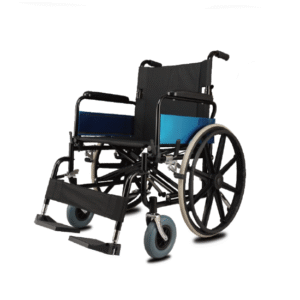Obese Wheelchair: 5 Key Questions Answered—From Weight Capacity to Comfort & Accessibility
For obese individuals with mobility limitations, a standard wheelchair often falls short—too narrow, unstable, or unable to support their weight. An obese wheelchair is engineered to solve these challenges, prioritizing safety, comfort, and dignity for larger body types. But what defines this specialized mobility aid, and how does it meet unique needs? Here are 5 critical questions answered.
1. What Defines an Obese Wheelchair?
An obese wheelchair is a heavy-duty mobility aid designed explicitly for individuals with higher weights and wider body frames. Key specifications include:
- Weight Capacity: 300–1,000+ lbs, with ultra-heavy-duty models supporting up to 1,200 lbs—far exceeding standard wheelchairs (250–300 lbs) or even mid-range bariatric models (300–450 lbs).
- Dimensions: Seat widths of 24–30+ inches (accommodating hips 22+ inches wide) and seat depths of 18–24 inches (supporting full thigh length without pressure on knees). Overall width (including wheels) ranges from 36–48+ inches to ensure stability.
- Frame Design: Reinforced with heavy-gauge steel or industrial-grade aluminum to resist bending under extreme weight, with reinforced joints at the seat, wheels, and footrests.
2. How Does It Differ from Other Wheelchairs?
Its design prioritizes extreme strength and space without sacrificing functionality:
- Standard Wheelchairs: Standard models (16–18 inch seats, 250–300 lbs capacity) risk frame collapse or discomfort for obese users. Obese wheelchairs add 6–12 inches of seat width and 50–700+ lbs of weight capacity.
- Bariatric Wheelchairs: While often used interchangeably, “obese wheelchair” typically refers to models supporting 500+ lbs with wider seats (28+ inches), whereas “bariatric” may include smaller 300–450 lbs capacity chairs.
- Large Wheelchairs: Large wheelchairs (20–24 inch seats) focus on width but lack the reinforced frames needed for 400+ lbs. Obese wheelchairs combine width with industrial strength.
3. Who Needs an Obese Wheelchair?
It’s essential for individuals whose needs exceed standard or mid-range bariatric options:
- Morbidly Obese Users: Adults or teens with body weights 300+ lbs, where standard chairs cause pain, instability, or frame damage.
- Users with Obesity-Related Conditions: Arthritis, joint pain, or limited mobility (common in obese individuals) require chairs that reduce strain during transfers and movement.
- Long-Term Users: Those needing 6+ hours of daily seating need pressure-relief features to avoid sores, a hallmark of obese wheelchair design.
4. Key Features for Safety & Comfort
- Pressure Relief: Extra-thick seats (4–6 inches) with memory foam or gel cushions distribute weight evenly, reducing risk of pressure sores on the tailbone and thighs. Some models add “tilt-in-space” functions to reposition users without manual lifting.
- Stability Enhancements: Wide wheelbases (36–48 inches) prevent tipping, while anti-tip bars (standard on most models) add security during transfers or uneven terrain.
- Maneuverability: Despite size, quality models have large rear wheels (20–24 inches) with ergonomic hand rims, making self-propulsion feasible for users with upper-body strength. Heavy-duty casters (8–10 inches) glide over carpets and sidewalks.
- Accessibility Aids: Removable armrests and swing-away footrests simplify transfers to beds or chairs—critical for users with limited mobility.
5. What to Consider When Buying
- Weight Capacity: Choose a model rated 100–200 lbs higher than the user’s weight (e.g., 600 lbs capacity for a 450 lbs user) to account for clothing, bags, or medical devices.
- Space at Home: Measure doorways, hallways, and furniture gaps. Most obese wheelchairs need 36+ inch doorways; narrower spaces may require swing-away hinges or custom modifications.
- Transport Options: Manual models (50–80 lbs) may fit in adapted vans with lifts; powered obese wheelchairs (100+ lbs) require heavy-duty lifts or specialized transport.
- Cost & Coverage: Manual models range from $800–$2,500; powered versions cost $3,000–$5,000+. Insurance often covers them with a doctor’s note confirming medical necessity.
Conclusion
An obese wheelchair is more than a mobility aid—it’s a tool that restores independence and dignity. By combining extreme weight capacity, tailored comfort, and practical design, it empowers obese users to navigate daily life with confidence. For those who need it, this specialized wheelchair is a critical investment in quality of life.
Thank you for reading this, dear, if you have any suggestions about our website or want to know about wheelchair, please contact us. We will respond quickly.

